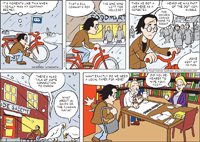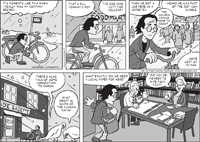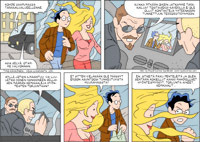
|
|
PDF CREATOR
|
|||
COMICS |  | PUBLISHERS |  | NEWS |  | COMPANY |  | CONTACT |  | FEEDBACK |  | ABOUT |  |  |
Royal Comics Syndicate selects comics for distribution from top professionals and ensures high technical and artistic standards - while leaving the artists room to breathe.
Price is determined by publication frequency and circulation. Contact us for a low-price quote. Invoicing occurs after delivery of each batch - terms of payment are either prepayment or credit payment. Credit payment is only available in Finland, and only for those customers who have received a positive credit decision from us. For orders from outside Finland, prepayment is always required.
Prepayment means that the customer receives the material after paying the invoice. Credit payment means that the customer pays the bill after delivery of the material. This should not be confused with payment by credit card, which is one of the payment methods we accept when paying from outside of Finland.
The comics are located on our high-performance server, which will be updated as necessary for increased loads. At pre-arranged intervals you will receive links via email so you can download the publication material quickly and easily.
Delivery batch example. You can download files from the above link and use them for testing.
We have text and image material available if you would like to put together a news story presenting a comic and its authors.
Royal Comics Syndicate comics are not only enjoyable because of their content, but also due to their first-class visual appearance. Maintaining high print quality is a point of honor for us. The resolution of our comics files is high, and they duplicate well in both magazine and newspaper printing.
Line drawings Black and white line drawings (i.e. inking) are 1-bit image files (aka bitmap/lineart/monochrome) with 900-1200 dpi resolution and assumed publication width 7.323 inches (18.6 cm).
Coloring and color management The coloring files for the comics in our system are in the RGB color space. They are converted before delivery to the customer to the appropriate CMYK/GRAY/RGB color space. Coloring files have a resolution of 300 dpi. We are able to serve the printing processes in different countries because the colors of our PDF files are converted using the customer’s own color profile, either a continent-wide generic CMYK profile or, if necessary, even a custom profile made just for a specific printing press. The customer can also choose to receive the coloring in RGB mode and do a custom CMYK conversion.
File Formats The comics are stored in our system as TIFF files (photographs or photograph-like JPEG files). Files delivered to customers for printing are generally delivered as PDF files with inking and color combined.
In order not to leave anything to chance, we check the resolution and color spaces of image files intended for printing before delivery to the publication and also track print quality of the comics in the printed publication.
The work of scanning comics has increasingly shifted from repro houses to the desktop. It has been sad to watch changes in print quality from the 1980s to the 2010s. The transition from repros to the desktop has given rise to previously unknown problems . Nowadays we see printing products (especially newspaper comics pages) with images suffering from the following problems almost daily:
Pixelation means that the resolution of the inking is so low that pixels can be detected in the printing product with the naked eye. Increasing the resolution of inking removes the pixelation problem.
Dithering means that the inking is dithered even though the purpose had only been to dither the coloring. Dithering can be prevented by combining inking and coloring in a PDF file so the inking file remains 1-bit.
CMYK color misalignments result from the printing process, from the paper moving or mechanical parts shifting, and it always happens to some degree. How much these alignment problems stick out is greatly affected by whether the black has been marked for overprinting or not.
To ensure a high level of printing quality on our part, we collect inking and coloring from the authors as separate TIFF files, review the material visually, and check resolutions and color spaces. We always do color conversions and file formatting using the same formula, minimizing the possibility for human error. This approach ensures that the PDF file is visually and technically valid.
Further down on this page, (here and here), you will find test material which can be used to evaluate how our PDF files will work in your publishing system and how colors will be reproduced. The test material is available for newspaper printing, and there are two color profiles available to choose from (ISOnewspaper30v4 for the United States and ISOnewspaper26v4 for the rest of the world except Japan and India). These two sets of test material can be used for other printing methods and areas as well, with the proviso that the colors may not be optimally reproduced. Please note that we can convert the material into any of the most common color profiles (see this list), and the actual material delivered to clients for printing is top quality in terms of color management, regardless of printing method, paper quality, or which continent’s printing inks are used.
The table below has example images with comprehensive information about each. The two leftmost represent inking and coloring files as stored in our system. The next two (Color and Grayscale) are in PDF format, converted using a color profile widely used in newspaper printing in the United States. Download PDF files by clicking on the thumbnails and then feel free to test the material in your publishing system.
The destination profile used in the RGB to CMYK conversion was the ISOnewspaper30v4 profile.
The table below has example images with comprehensive information about each. The two leftmost are inking and coloring files as stored in our system. The next two (Color and Grayscale) are in PDF format, converted using a color profile widely used in newspaper printing around the world outside the United States, India, and Japan. Download PDF files by clicking on the thumbnails and then feel free to test the material in your publishing system.
Note! These test files are in Finnish, but if this is not your language, don't let that bother you as you test how the files perform in your publishing process.
Destination profile used in RGB to CMYK conversion was the ISOnewspaper26v4 profile.
To avoid having the quantity of material on this page grow too large, we have CMYK converted test material only for newspaper printing and only for some of our market regions. The above material (here and here) can be tested anywhere in the world, but final conclusions about color reproduction fidelity should not be made based on these files in other areas.
The table below lists all color profiles to which we currently have the capacity to convert. If necessary we can also do conversions based on user-supplied printing press color profiles or deliver images in RGB color space, allowing customers to do their own conversion. The customer must decide on one of the following color settings or profiles before ordering. For more information choosing a color profile, please contact us.
| Color profiles, which are part of a complete color management setting | |||
| Name of complete color management setting | RGB color profile / Rendering Intent / Black Point Compensation / Embed Destination Profile | CMYK color profile / Rendering Intent / Black Point Compensation / Embed Destination Profile | GRAY color profile / Rendering Intent / Black Point Compensation / Embed Destination Profile |
| NewspaperEurope | ISOnewspaper26v4 / Relative / Yes / No | ISOnewspaper26v4_gr / Relative / Yes / No | |
| EuropeISOCoatedFOGRA27 | Europe ISO Coated FOGRA27 / Relative / Yes / No | Dot Gain 25% / Relative / Yes / No | |
| Internet | sRGB IEC61966-2.1 / Relative / Yes / Yes | sGray / Relative / Yes / Yes | |
| Internet_thumbnail | sRGB IEC61966-2.1 / Relative / Yes / No | sGray / Relative / Yes / No | |
| embed_AdobeRGB1998.icc | Adobe RGB (1998) / Relative / Yes / Yes | ||
| NewspaperUSA | ISOnewspaper30v4 / Relative / Yes / No | ISOnewspaper30v4_gr / Relative / Yes / No | |
| NewspaperIndia | ICONSnewspaper26v5_1 / Relative / Yes / No | ICONSnewspaper26v5_1_gr / Relative / Yes / No | |
| USWebCoated(SWOP)v2 | U.S. Web Coated (SWOP) v2 / Relative / Yes / No | Dot Gain 20% / Relative / Yes / No | |
| USWebUncoatedv2 | U.S. Web Uncoated v2 / Relative / Yes / No | Dot Gain 20% / Relative / Yes / No | |
| USSheetfedCoatedv2 | U.S. Sheetfed Coated v2 / Relative / Yes / No | Dot Gain 20% / Relative / Yes / No | |
| USSheetfedUncoatedv2 | U.S. Sheetfed Uncoated v2 / Relative / Yes / No | Dot Gain 20% / Relative / Yes / No | |
| EuroscaleCoatedv2 | Euroscale Coated v2 / Relative / Yes / No | Dot Gain 15% / Relative / Yes / No | |
| EuroscaleUncoatedv2 | Euroscale Uncoated v2 / Relative / Yes / No | Dot Gain 15% / Relative / Yes / No | |
| JapanColor2002Newspaper | Japan Color 2002 Newspaper / Perceptual / Yes / No | Dot Gain 25% / Perceptual / Yes / No | |
| JapanColor2001Coated | Japan Color 2001 Coated / Perceptual / Yes / No | Dot Gain 15% / Perceptual / Yes / No | |
| JapanColor2001Uncoated | Japan Color 2001 Uncoated / Perceptual / Yes / No | Dot Gain 15% / Perceptual / Yes / No | |
| sRGBIEC61966-2.1 | sRGB IEC61966-2.1 / Relative / Yes / Yes | sGray / Relative / Yes / Yes | |
| AdobeRGB1998 | Adobe RGB (1998) / Relative / Yes / Yes | sGray / Relative / Yes / Yes | |
| AppleRGB | Apple RGB / Relative / Yes / Yes | sGray / Relative / Yes / Yes | |
| Other color profiles we use | |||
| RGB profiles | CMYK profiles | GRAY profiles | |
| Uncoated FOGRA29 (ISO 12647-2:2004) | |||
| Coated FOGRA39 (ISO 12647-2:2004) | |||
| Japan Web Coated (Ad) | |||
| Photoshop 4 Default CMYK | |||
| Japan Color 2003 Web Coated | |||
| Web Coated FOGRA28 (ISO 12647-2:2004) | |||
| Agfa : Swop Standard | |||
| KODAK DS 1000 PS Coated Paper | |||
| Photoshop 5 Default CMYK | |||
| Web Coated SWOP 2006 Grade 3 Paper | |||
| Web Coated SWOP 2006 Grade 5 Paper | |||
| Coated GRACoL 2006 (ISO 12647-2:2004) | |||
| Dot Gain 30% | |||
| Gray Gamma 1.8 | |||
| Gray Gamma 2.2 | |||
| Dot Gain 10% | |||
| Wide Gamut RGB | |||
| SDTV NTSC | |||
| * wsRGB | |||
| HDTV (Rec. 709) | |||
| SDTV PAL | |||
| e-sRGB | |||
| SMPTE-C | |||
| * wscRGB | |||
| CIE RGB | |||
| PAL/SECAM | |||
| ColorMatch RGB | |||
| ROMM-RGB | |||







